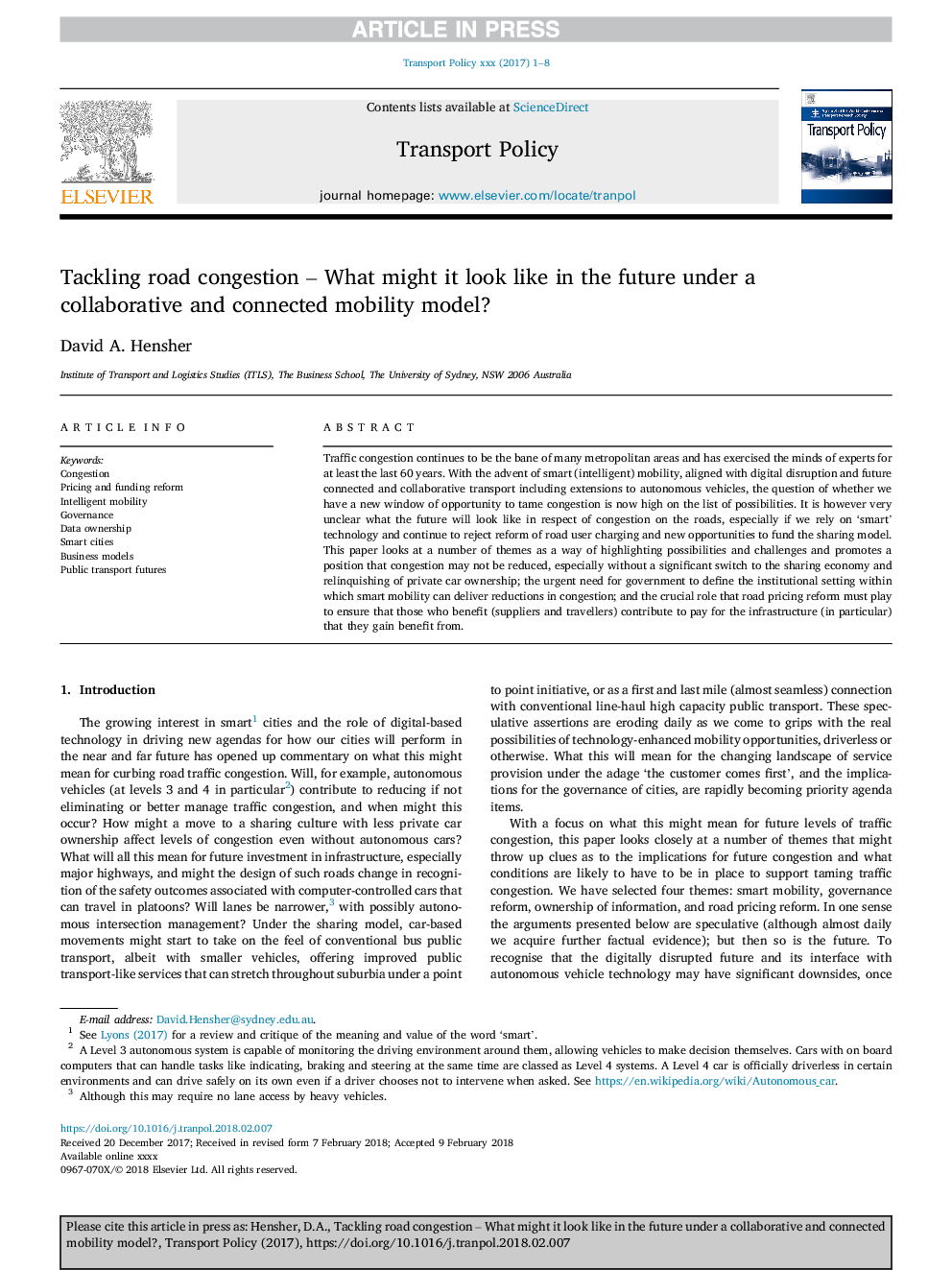| کد مقاله | کد نشریه | سال انتشار | مقاله انگلیسی | نسخه تمام متن |
|---|---|---|---|---|
| 7497025 | 1485811 | 2018 | 8 صفحه PDF | دانلود رایگان |
عنوان انگلیسی مقاله ISI
Tackling road congestion - What might it look like in the future under a collaborative and connected mobility model?
ترجمه فارسی عنوان
برطرف کردن احتقان جاده - چه چیزی ممکن است در آینده تحت یک مدل تحرک مشترک و مرتبط باشد؟
دانلود مقاله + سفارش ترجمه
دانلود مقاله ISI انگلیسی
رایگان برای ایرانیان
کلمات کلیدی
جابجایی، قیمت گذاری و اصلاح بودجه، تحرک هوشمند، حکومت، مالکیت داده، شهرهای هوشمند، مدل های کسب و کار، آینده حمل و نقل عمومی،
ترجمه چکیده
تراکم ترافیک همچنان نابارور از بسیاری از مناطق کلان شهر است و از نظر ذهن متخصصان حداقل 60 سال گذشته است. با ظهور تحرک هوشمندانه (هوشمندانه)، هماهنگ با اختلال دیجیتال و حمل و نقل متصل و همکاری در آینده از جمله گسترش به وسایل نقلیه مستقل، سوال این است که آیا ما یک پنجره جدید از فرصت برای تردد تراکم وجود دارد در حال حاضر در لیست امکانات است. با این وجود بسیار مشخص نیست که آینده در مورد جابجایی در جاده ها، به ویژه اگر ما به تکنولوژی "هوشمند" تکیه کنیم و همچنان رفع شارژ کاربر جاده ها و فرصت های جدید برای تأمین مالی مدل به اشتراک گذاری را رد کنیم. این مقاله به تعدادی از موضوعات به عنوان راهی برای برجسته کردن فرصت ها و چالش ها اشاره می کند و موقعیتی را پیش می کشد که ممکن است کاهش بار احتمالی، به ویژه بدون تغییر قابل ملاحظه ای در اقتصاد به اشتراک گذاری و از دست دادن مالکیت خصوصی خودرو؛ نیاز فوری به دولت برای تعریف ساختار نهادی که در آن تحرک هوشمند می تواند کاهش تراکم را کاهش دهد؛ و نقش حیاتی که اصلاحات قیمت گذاری جاده ای باید بازی کند تا اطمینان حاصل شود که کسانی که به نفع خود (تامین کنندگان و مسافران) برای پرداخت هزینه های زیربنایی (مخصوصا) از آن بهره مند شوند.
موضوعات مرتبط
علوم انسانی و اجتماعی
علوم اجتماعی
جغرافیا، برنامه ریزی و توسعه
چکیده انگلیسی
Traffic congestion continues to be the bane of many metropolitan areas and has exercised the minds of experts for at least the last 60 years. With the advent of smart (intelligent) mobility, aligned with digital disruption and future connected and collaborative transport including extensions to autonomous vehicles, the question of whether we have a new window of opportunity to tame congestion is now high on the list of possibilities. It is however very unclear what the future will look like in respect of congestion on the roads, especially if we rely on 'smart' technology and continue to reject reform of road user charging and new opportunities to fund the sharing model. This paper looks at a number of themes as a way of highlighting possibilities and challenges and promotes a position that congestion may not be reduced, especially without a significant switch to the sharing economy and relinquishing of private car ownership; the urgent need for government to define the institutional setting within which smart mobility can deliver reductions in congestion; and the crucial role that road pricing reform must play to ensure that those who benefit (suppliers and travellers) contribute to pay for the infrastructure (in particular) that they gain benefit from.
ناشر
Database: Elsevier - ScienceDirect (ساینس دایرکت)
Journal: Transport Policy - Volume 66, August 2018, Pages A1-A8
Journal: Transport Policy - Volume 66, August 2018, Pages A1-A8
نویسندگان
David A. Hensher,
